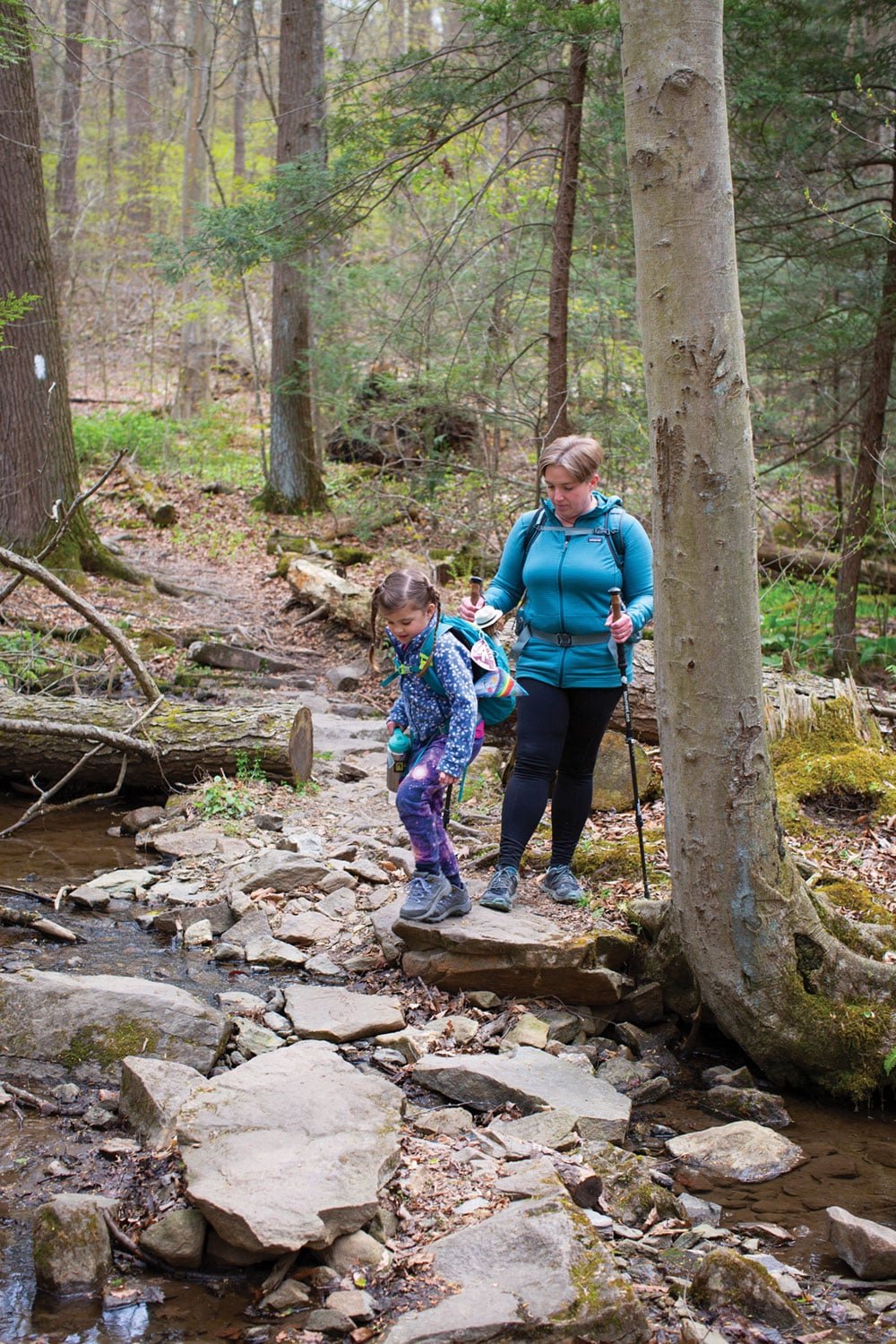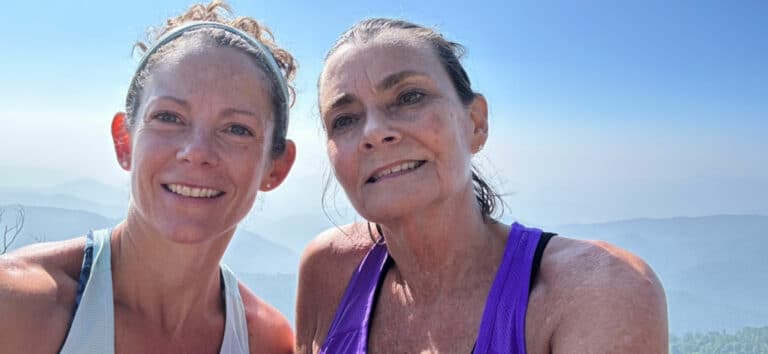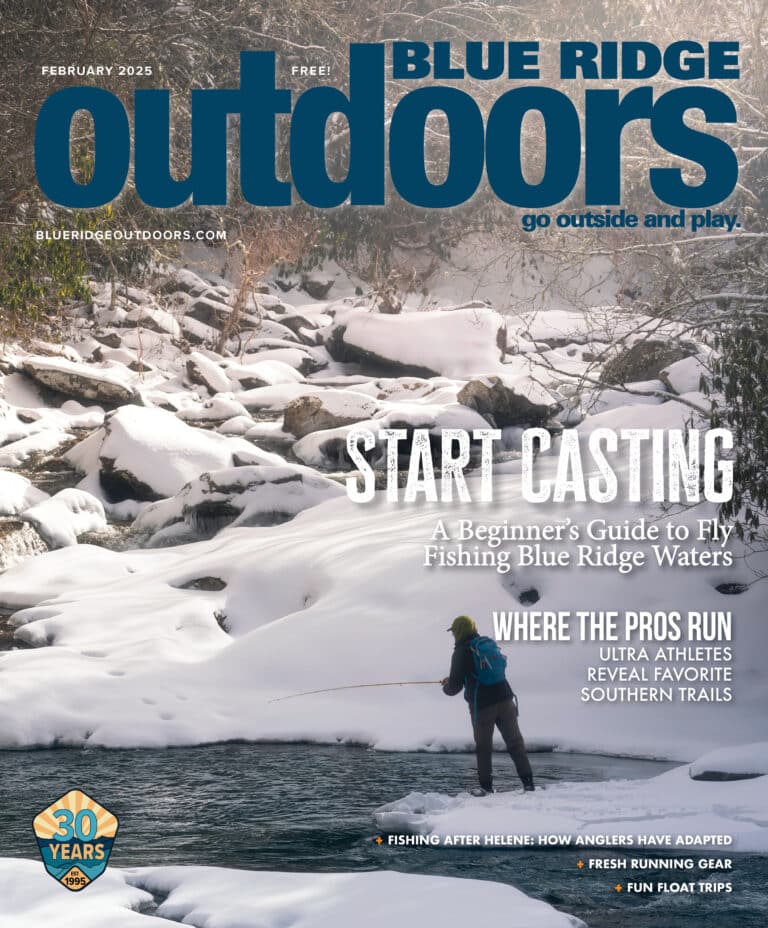On her desk at work, Charissa Hipp has a picture drawn by her daughter, Julia. In it mother and daughter are sitting at their favorite overlook on the Appalachian Trail watching the sunset. Beneath the image, Julia wrote, “I like me because I can do really hard things.”
Julia, 6, drew the picture during a difficult year in which she slogged through virtual pre-school before starting in-person kindergarten, all while living through a pandemic. “I thought that was such a great representation of what our time outside has given to her—self-confidence,” Hipp said.
That self-confidence, and other benefits of time spent outdoors, can feel far away, especially in a convenient, technologically inundated world, where words like the Metaverse and non-fungible tokens have been added to our vocabulary. But many Blue Ridge-based parents are prioritizing more green space and less screen time and committing to fostering a relationship between their kids and nature.
Trail Time Together
Hipp has been bringing her daughter hiking since she was an infant, although Julia was sound asleep against her mother’s chest during most of those early outings. Born with low muscle tone, Julia didn’t start walking until she was 17 months old, so Hipp was initially cautious about how much she pushed her daughter, mostly taking her on the flat C&O Canal Towpath in their backyard of Williamsport, Md. As Julia wanted to spend less time in the backpack carrier, Hipp increasingly found herself hiking solo in order to explore more strenuous terrain.
Then, in the early days of the pandemic, Hipp began taking Julia on more hikes to get her out of the house while her two older children attended virtual classes. During one particular hike, Hipp realized Julia wasn’t having any trouble keeping up. “From that day on, we started doing more challenging trails, building distance and difficulty,” she said. “It was only my thoughts that were limiting us.”
During one particular hike, Hipp realized Julia wasn’t having any trouble keeping up. “From that day on, we started doing more challenging trails, building distance and difficulty,” she said. “It was only my thoughts that were limiting us.”
Julia has since completed the 52 Hike Challenge, an effort that motivates people to hike at least once a week, for the past two years. And as some of their favorite trailheads became more crowded, Hipp and her daughter started seeking out more remote spots on the A.T. Julia, who received the trail name Pigtails for her recognizable hairdo, especially loves pointing out the white blazes and trail markers along the way.
A former park ranger, Hipp likes to incorporate history into their hikes whenever possible. Along the way, they’ll also take photos of different flora that stand out to them so they can learn more about the species when they get home on the iNaturalist app. “She’s like a sponge soaking up all of that information, and it’s amazing how much of it she retains,” Hipp says of her daughter.
Hikes with Julia are a chance to slow down and notice details, as opposed to logging miles and elevation change. Her daughter remembers beech trees hang onto their leaves through the winter and points them out along the trail. “Julia is the best nature therapy guide,” Hipp said.
Hipp’s biggest takeaway from hiking with her daughter is that kids are more resilient than adults often perceive. Spending so much time on the A.T., she often gets asked if she thinks Julia will attempt a thru-hike when she’s older. “I think it would be awesome if she did someday, but I can’t say what she’s going to do tomorrow,” she said. But by taking her daughter hiking at an early age, she believes she’s put her on a path with bigger possibilities.

Back to the Land
On the very first night her family spent in their new camper, Summer Clae’ Trepen remembers the moment the generator turned off at 3 a.m. “Hearing owls at night was definitely not something we were accustomed to,” she said. “In that brief moment, I really felt like we were in the middle of nowhere.”
As the end of last summer approached, the South Carolina-based Trepen family downsized from a five-bedroom house in a cookie-cutter neighborhood in North Charleston to a camper on a sprawling farm about 45 miles north. Previously, the family tended to a few backyard raised beds and raised eight laying hens, but their neighborhood didn’t offer enough space for all they wanted to do. Now Trepen and her husband, Kevin, have plans to build up a farm stand while homeschooling their two boys, Archer, 5, and Sullivan, 2. With spring in full swing, they plan to start selling free-range eggs, homemade jam made with seasonal local fruit, fresh cut flowers, and other homegrown goods.
With 10 acres in Cross, S.C., the family is taking on the tasks required to get everything up and running together. From an assortment of laying hens, ducks, bees, and other farm animals to tending the gardens of fruit trees, seasonal raised beds, and a greenhouse, there’s plenty to keep everyone busy. “The boys are always very excited to help, and even if it takes twice as long to get done, I try to encourage this whenever possible,” Trepen said.
It’s been a lot of work, as the family adjusts to growing much of their own food, but the many tasks—collecting eggs, feeding the animals, watering the gardens, and cleaning out the coops—are divided reasonably. And the kids are happily participating. Every night, without fail, Archer asks what they’re doing the next day, and Sullivan has succeeded in germinating a few things on his own including nasturtium, peppers, and cosmos.


Trepen and her husband decided to homeschool in order to provide a more flexible and well-rounded experience, and homesteading plays a large role in teaching essentials like growing and preparing food. “This time we have together, even if we don’t fill the day with much of anything, is really a gift that some will never have the privilege of having,” Trepen said. In pursuing the things that interest them, the boys are always learning. “Sometimes it’s learning reading and math, and other times it’s learning how to be present and thankful for a picnic by the pond on a sunny 75-degree day,” Trepen said.
The family garden also teaches a great number of lessons, including colors, counting, life cycles, seasons, and even marketing goods. But even more importantly, it emphasizes the importance of asking questions, finding joy in the seemingly ordinary, and feeling a sense of peace in an increasingly busy and distracted world. “I hope that they will learn to be confident and remember that they are capable of making a difference for the better,” Trepen said.
While Trepen focuses on the farm full-time, her husband still commutes to North Charleston for his day job four days a week. And while neither of them has homeschooling or homesteading backgrounds, they’re drawn to trying something different as they shape a different life for their children. Encouraged by the process of doing new things, it’s a challenge they’re all taking on together.

The Road Rules
Alison Durham and her family have been camping since the kids were young, but at the start of the pandemic she convinced her husband, Chris, to commit to a camper. Years of storing tents, cookware, and gear in the garage had deterred taking more trips. “When we got back, I always felt like it was a lot to unpack everything and put it back in its place,” she said. But with everything already loaded in the vehicle—linens, towels, beds—they could quickly pack some food and hit the road.
Over the last two years, the Durhams have visited 37 out of 41 North Carolina state parks with plans to see the remaining four in the coming months.
The plan worked. Over the last two years, the Durhams have visited 37 out of 41 North Carolina state parks with plans to see the remaining four in the coming months. According to Durham, basing family free time around adventure travel has made her kids— Channing, 10, Emory, 8, and Ophelia, 6—more curious. They all carry backpacks with snacks, magnifying glasses, and their favorite plant and animal track identification books. “Sometimes I want to get to the destination but they’re like no, we need to identify these leaves,” Durham said.
At campsites, the kids are also more willing to help with chores than they are back at home. “They will fight over who gets to ignite the stovetop for me to cook dinner,” Durham added. “They’re like, ‘Mommy, what can I do? Can I flip the pancakes? Can I make the sausage?’”

Filled with hiking, biking, and paddling, the trips often push the kids out of their comfort zones. But when they overcome steep trail sections and tired legs, Durham notices her children appreciate the amazing rewards, like sweeping views, tumbling waterfalls, and cool creeks. The family also makes time to visit sites of Black history. “Those weren’t places we were welcome historically,” Durham said.
The experiences are resonating. Durham especially enjoys hearing the way her kids talk about their adventures with friends back at home, and she’s optimistic this appreciation for the outdoors will continue. While paddling the swampy waters of Merchants Millpond State Park, she heard one of her sons announce it was a place he wanted to take his kids one day.
Reading List: Kids’ Books That Inspire Adventure
BRO collected a roundup of book recommendations from the Hipps, Trepens, Durhams, and other outdoor families in our region to help inspire your child’s next adventure. Whether you’re curled up at home or beneath the stars, these are adventures you can take with you anywhere.
Folly and Molly Take on the Appalachian Trail
- Written and illustrated by Michelle Adshead
- Recommended Ages: 3 to 7
Perfect for future thru-hikers, follow along with Folly and Molly as they make the trek from Georgia to Maine. This rhyming picture book helps break down what it takes to hike all 2,190+ miles of the A.T., in addition to exploring a love of nature and backpacking.
The Outdoor Scientist
- Written by Temple Grandin
- Recommended Ages: 8 to 12
This collection of essays and observations features 40 projects that will help kids form a better understanding of nature, from the backyard to the deepest reaches of space. Learn about the world of astrophysicists, geologists, oceanographers, and inventors studying the wonders of the world.
We Are Water Protectors
- Written by Carole Lindstrom, illustrated by Michaela Goade
- Recommended Ages: 3 to 6
Inspired by Indigenous-led movements like the Dakota Access Pipeline protests at Standing Rock, this lyrical and beautifully illustrated book tells the story of the importance of protecting water sources through community.
Nature Anatomy
- Written and illustrated by Julia Rothman
- Recommended Ages: 6+
Combining art and science, children of all ages will learn something new through illustrations and interactive activities. These pages will have you paying closer attention every time you head outside. Discover even more in the rest of the series, including ocean, food, and farm anatomy.
The Lost Art of Reading Nature’s Signs
- Written by Tristan Gooley
- Recommended Ages: 10+
Trees, butterflies, stars, and clouds are more than just interesting things to look at while spending time outside. Learn how interpreting nature’s clues can help with forecasting, tracking, and navigation.
Fatima’s Great Outdoors
- Written by Ambreen Tariq, illustrated by Stevie Lewis
- Recommended Ages: 4 to 8
Written by the founder of Brown People Camping, the story follows a family on their first camping trip to a local state park. Fatima realizes her own abilities as she learns to set up a tent and start a fire while spending time with her family.
Lumberjanes
- Written by Shannon Watters, Grace Ellis, and Noelle Stevenson, illustrated by Brooke Allen
- Recommended Ages: 9+
This comic book series follows five friends through their time at a summer camp, as they encounter supernatural happenings while trying to earn scout badges. Together, they make sure nothing gets in the way of their awesome summer.
Outdoor Kids in an Inside World
- Written by Steven Rinella
- Recommended Ages: Adults
Set to be released in May 2022, this book offers practical advice for engaging with kids outside, interspersed with personal anecdotes about overcoming struggles.
Cover photo: Julia, left, and Charissa Hipp hike a section of the A.T. in Maryland. Photo by Szemere Photography @szemerephoto







